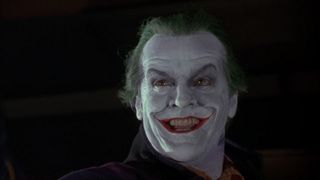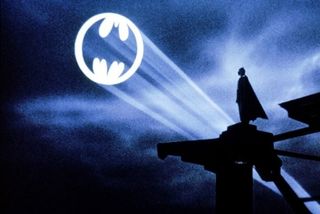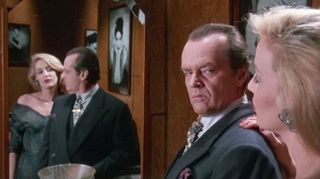It's 25 years since Tim Burton's Batman ignited a new generation of Batmania. Time to celebrate the Dark Knight's dance with the Devil in the pale moonlight...

“I’m Batman!”
MICHAEL KEATON
Michael Keaton was a provocative, almost perverse casting choice. Scrawny and nervy, with a face full of haunted mischief, he’s far from the traditional Batman archetype, whether that’s the lean and graceful nightbird of the ‘70s strips or the barrel-chested, box-jawed ‘50s incarnation. His Bruce Wayne is also bold and new: a tripwire-neurotic in place of a playboy charmer, a sweet, distracted figure who needs the Bat-suit to find fire and purpose in his life. A fan-baiting choice, but a stroke of genius by Burton - Keaton captures the primal wound of the Waynes’ alleyway slaying better than any other screen Batman. As Vicki Vale so perspicaciously says, “You’re not exactly normal, are you?”

“You can call me… Joker!”
JACK NICHOLSON
Jack Nicholson devours Batman ; it’s not so much a performance as a heist. If Keaton was a brilliantly skewed piece of casting then Nicholson’s appointment as the Clown of Crime was a no-brainer. Sure, he’s a shorter, chunkier presence than the spectral, gangling bone-bag of the comic books, but he nails the contagious, crowdpleasing insanity of the character (“I thought I was a Pisces!”). In truth Nicholson had been building that persona – dancing with the Devil in the pale moonlight – since Easy Rider , and so perfectly did role and actor fit, so blindingly right was the choice, that it eclipsed him ever after. Batman finds him at the summit of his starpower, and arguably at the end of it, too.

“This town needs an enema!”
THE PRODUCTION DESIGN
Gotham City is the American dream in a state of slow decay. Its skyscrapers aren’t aspirational spires; they’re jagged giants, looming like fallen gods, casting brutish shadows over its hope-starved citizens. “As if Hell had erupted through the sidewalks and kept on growing,” as the screenplay noted. Blending Russian Futurism, Art Deco and pure urban nightmare, it’s the vision of gifted production designer Anton Furst, who also gives us the industrial menace of Axis Chemicals, all rust and pipes and smoke, squatting on the edge of town like some toxic haunted house. His Batmobile, meanwhile, is frankly gorgeous, racing like a blade through the grime.

“I just like the sound of it…”
DANNY ELFMAN
Burton’s longtime musical collaborator Danny Elfman gives us the last great superhero theme (have you tried humming Spider-Man , X-Men or The Dark Knight lately?). A lonely prelude builds with chimes like cold night rain before moving into a martial rush that sounds like a vaguely psychotic marching band. It’s urgent, violent, romantic; melancholy and triumphal all at once, a fittingly troubled, nocturnal cousin to John Williams’ immortal Superman theme. Elsewhere Elfman scores the Batmobile’s race through the woods with a majestic riff on Carl Orff’s Carmina Burana, long before it became the default setting for every last trailer in the world.

“Little song, little dance”
PRINCE
By 1989 Prince’s career was high-wiring between mainstream heat ( Purple Rain ), critical acclaim ( Sign O’ The Times ) and blanket derision (ill-conceived vanity flick Under The Cherry Moon ). Imagine the faces of the suits when the bonsai funk-imp delivered Batdance, lead single from his Batman soundtrack. It sounds like a jam session in a fritzed-up hard drive, an ADD slalom race of ideas, mixing loops, grooves, sobs, squiggles, fragments of movie dialogue and - in a deliriously off-brand move - the “Batman!” refrain from the ‘60s TV show. It may have been a wilful choice of tie-in single but Prince’s score adds a layer of late ‘80s charm to the movie – Partyman proves the perfect accompaniment to the Joker’s delicious vandalism spree in the art museum while Arms Of Orion adds a touch of pop swoon.

“Thieves and terrorists”
'40s STYLE
Burton’s Batman universe exists somewhere between Scorsese and Chandler, Taxi Driver and The Big Sleep . It’s a timeless place, dressed with gangster flick chic, populated by ‘40s throwbacks in sharp suits and angled fedoras (very on-trend for the Summer of ’89, fashion hounds – even Madonna rocked a double-breasted whistle in the “Express Yourself” video). See it as a tribute to Batman’s Depression era origins, when the Gotham knight shared newsstand racks with such insalubrious company as Crime Does Not Pay and Murder Incorporated . Burton’s fondness for these hoods is ironic given the mob links associated with the birth of the comic book industry.

“You ever danced with the Devil?”
TIM BURTON
There’s a huge tension in Batman – a tension between Tim Burton the candystriped auteur and Tim Burton the hired hand, drafted to craft a summer blockbuster for big studio paymasters. From Keaton’s casting on there’s a sense of the movie fighting its tentpole trappings. Straight-ahead superhero storytelling battles familiar Burton flavours, from black comedy (the grisly hilarity of Nicholson’s one-way dialogue with an electrocuted corpse) to fairytale (the Batmobile thunders through a storybook forest, autumn leaves swirling in its wake) to dark carnival (the Joker’s parade, with its grotesque, bobbing balloons of death). He would have his head with 1992’s Batman Returns – a film with such a deviant shiver that it scared away McDonalds – but Batman may be the more intriguing, satisfying film.
Nick Setchfield

